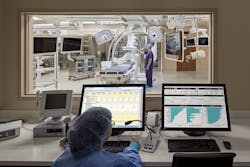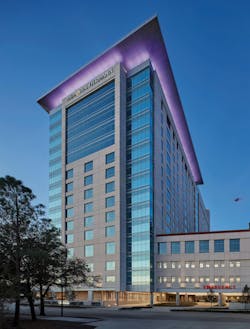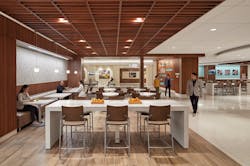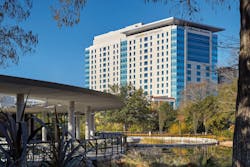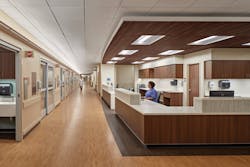'Breaking New Ground Room' helps deliver new Houston medical facility
By BD+C Staff
Silver Award
Memorial Hermann Sarofim Pavilion, Houston, Texas
Project information
Project size: 1.3 million sf
Project cost: $700 million
Construction time: June 2016 - January 2020
Delivery method: CM at risk
Building team
Submitting firm: EYP
Owner/Developer: Memorial Hermann Health System
Architect: EYP
Structural engineer: IMEG
MEP Engineer: SSR
General contractor: Vaughn Construction
Program manager: Broaddus
Essay from EYP
The Memorial Hermann Susan & Fayez Sarofim Pavilion is a $700 million state-of-the-art expansion and renovation in the heart of the Texas Medical Center designed to expand ability to deliver lifesaving care to critically ill and injured patients. A collaborative effort by the OAC+E team, the Sarofim Pavilion was a seven-year design and construction project in which both the Process and Team Culture manifested the same level of care, expertise, and rigor provided to the hospital’s patients themselves.
Highlights of the Memorial Hermann Susan & Faye Sarofim Pavilion
• Stakeholder Engagement: Stakeholders engaged from start to finish – Masterplanning through Construction
• Budget and Schedule: Successful management of complex budget and schedule challenges. Owner asked for a peer review of budget and schedule at 50% CDs. After an intensive 10-week cost and schedule analysis, the Team presented a refined GMP that significantly lowered the cost and improved the schedule.
• Unparalleled Team Collaboration: Team planned and built dedicated ‘Breaking New Ground Workroom’
• Complex Phasing: Successful Management of Complex Phasing using design assist. The team developed individualized approaches to address each facility’s needs.
• Complex Site: In the end, the Team was able to develop this project on a site that never existed previously.
The Sarofim Pavilion and Parking Infrastructure Building added 1.34 million SF to Memorial Hermann’s Texas Medical Center existing campus. Standing at 18 stories, the tower connects to Memorial Hermann’s occupied main hospital via a new four-story podium. The new tower doubles the emergency department size to 76,000 SF and adds 186 new patient rooms, 16 ICU rooms, and 20 burn units. Its second and third floors house 24 new operating rooms (OR), three of which are hybrid ORs to accommodate image-guided interventional surgical procedures. These floors also include a neuro-hybrid OR, pediatric cardiovascular hybrid OR, and a pediatric catheterization lab. Level 18 serves as command central for the Life Flight helistop.
Supporting the Pavilion, the nine-level, 968 vehicle, Parking & Infrastructure Building included a 335-seat dining area, loading dock, chilled water distribution, emergency generators, shell space for a future kitchen expansion, and the supporting infrastructure for a complete replacement of the campus essential electrical system.
The “Breaking New Ground Room”
Before designing 1.34 million sf of hospital, the Team came together to plan and build 1,300 sf. This space, dubbed the “Breaking New Ground Room” served as the project home base over the next seven years from Masterplanning through Construction – providing important continuity to the many planning sessions, user group meetings, stakeholder presentations, construction coordination sessions, mockup reviews and more. Over time, the theme “Breaking New Ground” grew to symbolize the mission of the project and attitude of the OAC+E Team.
Memorial Hermann Sarofim Pavilion Challenges
The single biggest challenge involved the rerouting of electrical services and emergency power from the existing central plant to the new Parking Infrastructure Building without disrupting critical functions that operate 24/7 in a facility where life-saving procedures are performed. Memorial Hermann made it clear the hospital was to have zero time without an emergency power source. The OAC+E worked hand-in-glove with the electrical trade partner to perform weeks of make-ready activities for each refeed so the transitions could occur quickly, only seconds in most cases. The transitions were so seamless, most of the building users had no idea the feat we had accomplished.
Flooding, hurricanes, and other natural disasters pose a real threat to the Greater Houston region as well as the infrastructure within the Texas Medical Center. Storm events like Tropical Storm Allison, and more recently Hurricane Harvey, devastated the TMC and emphasize the need for proactive, preemptive safeguards to ensure the continuous care of hospital patients. Based on Owner requirements, the AEC Team implemented a series of resiliency measures including 24’ wide flood control gates at entries to the garage, five diesel powered generators and hurricane rated exterior glass in addition to raising critical infrastructure out of the flood plain.
Flexibility
All patient rooms and nursing units are designed around a single chassis and allow long-term flexibility to change the unit easily (with certain minimal modifications). This strategy has proven to be extremely beneficial since the Owner decided to convert one of the floors from acute care to critical care during the construction process.
From a Phasing perspective, the process required the Team to minimize disruption to the existing programs within the adjacent Hermann Pavilion. Seamless construction sequencing was accomplished by developing detailed phasing plans using evidence-based design solutions to achieve maximum standardization and flexibility throughout the project. This approach allowed for the prefabrication of various components, enabled better quality control, and faster construction.
